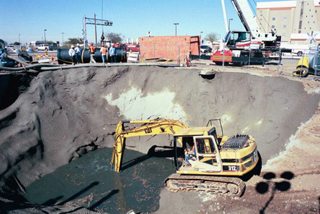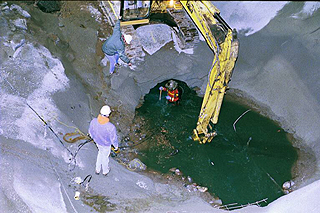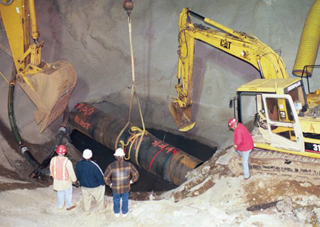
DJC.COM
September 12, 2007
Infrastructure: out of sight, out of mind?
Brown and Caldwell

Photos courtesy of Brown and Caldwell A 54-inch-diameter sewer collapsed in 2001 in Phoenix. The 20-foot-deep sewer was severely corroded, eventually causing a 15-foot-long hole. When the line collapsed, pipe, earth, rock and asphalt fell into it, causing it to surcharge and further erode the area. |
The collapse of a commuter bridge in Minneapolis last month is but one visible example of how fragile our usually invisible infrastructure has become in many American cities. Buried water/sewer mains are equally suspect and are often ignored until a failure occurs.
And the Pacific Northwest is no exception.
Case in point: When a water main broke under the south end of the University Bridge in Seattle, it caused not only a large sinkhole that swallowed two cars, it triggered a traffic nightmare. The surprise flood also cut off or slowed water to hundreds of residents and blocked vehicle access to dozens of homes.
Although they are rare, the water main break was the city’s second in a little more than a week. Seattle has one of the lowest line-break rates in the country, with about eight per month. The cast-iron main that failed near University Bridge was installed in 1917, and utility officials say they can last 150 to 200 years.
There’s also the state of Washington’s levees. The Army Corps of Engineers, in a 2007 report, identified 19 suspect levees in our state, second only to California’s 37. And King County estimates $179 million to $335 million will be needed over 10 years to fix some 500 levees in the county.
In Portland, a sinkhole created by a collapsed sewer line swallowed an entire truck and ruptured a natural gas line and water line in December 2006.
In Idaho last January, the Idaho Transportation Department found a 30-by-30-inch piece of decking dangling from a U.S. Highway 2 bridge in Dover. The bridge, built in 1937, is classified as “intolerable” for structural condition and “poor” for superstructure and substructure by the ITD. The department also pushed back replacement of the bridge for at least 10 years, despite a 2 rating out of 100, with 0 representing an entirely deficient bridge and 100 representing a completely sufficient bridge.
Stories like these are fast becoming the norm across most of the country. The American Society of Civil Engineers estimates that $1.6 trillion is needed over a five-year period to bring the nation’s infrastructure to a good condition. And it released the 2005 Report Card for America’s Infrastructure, giving the nation’s overall infrastructure a D, with wastewater and drinking water infrastructure each receiving a D-.
Infrastructure funding gap

Specially trained divers were used to verify conditions and help clean debris. |
Since World War II, many of the country’s water and wastewater utilities have been in a mode of planning and constructing new facilities. Their investment has been immense, as high as $25,000 per customer account. Even relatively small utilities may have total infrastructure investments in excess of $1 billion.
Today, however, many utilities are finding that maintaining existing infrastructure is their main line of work. Even those still doing major construction often have extensive infrastructure old enough that replacement and rehabilitation is a significant part of their business.
Analyses of asset failures, practiced over time, will give us the knowledge we need to manage our assets to achieve the lowest costs along with the highest service levels, as well as the long-term planning data that utility managers desperately need. Imagine if we had started analyzing and recording asset failures 50 years ago.
Washington water and wastewater utilities understand that there is an infrastructure funding gap and many have started formal asset management programs. By instituting those programs, entities such as the King County Wastewater Treatment Division, Seattle Public Utilities, Pierce County Sewer Utility and the LOTT Alliance can verify to their ratepayers that they are effectively operating, maintaining, refurbishing and replacing the billions of dollars of assets they are responsible for. Through asset management they are making documented and justified decisions for prioritizing their needs.
Asset management involves asking and answering questions such as:
• Which asset should I buy? What will be its whole-life cost of ownership?
• How can it fail? What should I do to anticipate or avoid failures?
• What applications is it suitable for? What applications should be avoided?
• Given the way I will use the asset, what are the optimum service intervals?
• What types of capital refurbishments can I anticipate during the asset’s life? What will they cost?
• How long a life can I reasonably expect? And how will I know that the time for replacement has arrived?
Helping coming
When new facilities and major refurbishments are required, who pays? As stated there is a $1.6 trillion need over the next five years in America. In the Puget Sound alone this translates to approximately $5,000 per person or an extra $88/month over the next five years.
To help lessen the burden on the ratepayer, the federal government is taking action.
Last month, the Senate passed the ASCE-endorsed National Infrastructure Improvement Act, a bill that would establish a national commission to assess the physical condition of America’s infrastructure and recommend ways to improve it.

The line was temporarily fixed by inserting a smaller diameter steel pipe into the existing concrete and sealing the connections. |
Also in August, the House of Representatives approved the Water Resources Development Act of 2007 by a vote of 381-40, more than enough votes to ensure the House can override a promised presidential veto. The bill authorizes approximately 400 new water resources projects for the U.S. Army Corps of Engineers, including projects for flood control, navigation and environmental restoration. The total cost of the bill was put at about $20 billion.
And a new bill was introduced in the Senate to establish a National Infrastructure Bank that would provide funding for qualified infrastructure projects, including wastewater and drinking water plants, public transit systems, roads and bridges, and public housing. The bill would create the National Infrastructure Bank as an independent entity of the federal government with an initial bonding ceiling of $60 billion. The bank would be required to evaluate and fund “infrastructure projects of substantial regional and national significance.”
This influx of needed funding in combination with utility prioritization through asset management are key steps in successfully closing our infrastructure gap.
Nancy Walker has more than 25 years of experience in environmental engineering and planning, systems management, water resources and quality, permitting and hazardous waste investigations. She is vice president and the manager of Brown and Caldwell’s Washington operations.
Other Stories:
- A beautiful tomorrow for structural engineering?
- 7 Engineering Wonders: Structural — How to keep it all working after the BIG ONE
- Engineering a sea change at the aquarium
- ACEC says ‘yes’ to roads and ‘no’ to lawsuits
- Engineers, architects join forces on public policy
- Is our engineering rank slipping in the world?
- 7 Engineering Wonders: Electrical/Communications — Engineering a hospital to save lives
- 7 Engineering Wonders: Mechanical — EMP: an experience unlike any other
- 7 Engineering Wonders: Environmental — Brightwater planning raises awareness, not eyebrows
- 7 Engineering Wonders: Transportation/Infrastructure — Tunnels keep traffic flowing out of sight
- 7 Engineering Wonders: Civil — Making the grade for a road separation
- 7 Engineering Wonders: Geotechnical — A firm foundation for the new Narrows Bridge
- Geotechnical engineering gets a tech boost
- Finding workers may be engineering’s biggest challenge
- ACEC members pick the best of 50 years
- What a difference 50 years make
- What makes engineers tick?
Copyright ©2009 Seattle Daily Journal and DJC.COM.
Comments? Questions? Contact us.